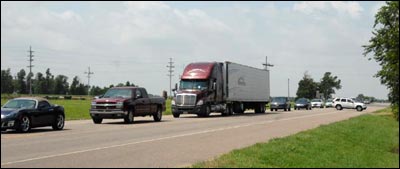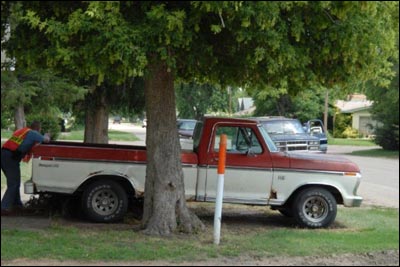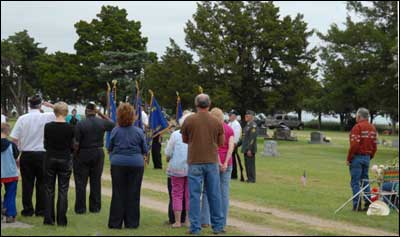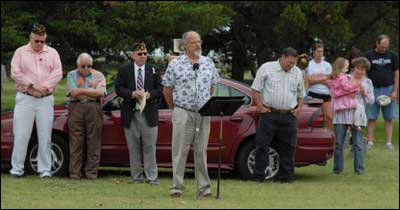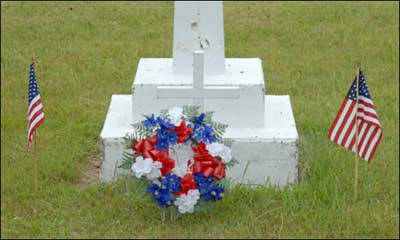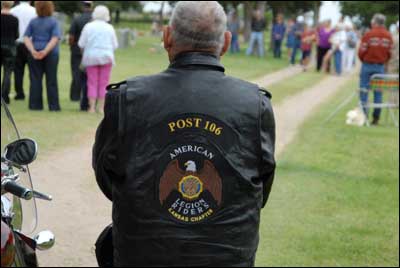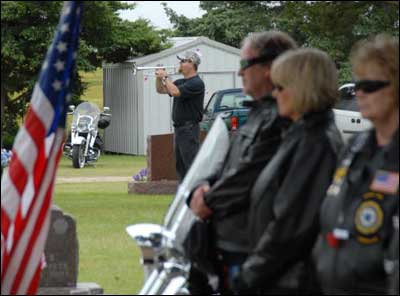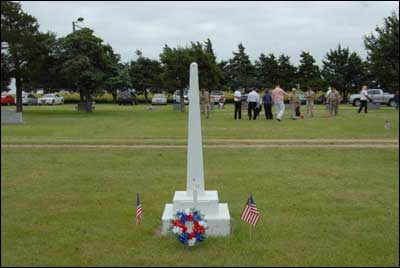
|
|
|
Search our site
Check these out    Do you have an entertaining or useful blog or personal website? If you'd like to see it listed here, send the URL to leon@pawneerock.org. AnnouncementsGive us your Pawnee Rock news, and we'll spread the word. |
Too Long in the WindWarning: The following contains opinions and ideas. Some memories may be accurate. -- Leon Unruh. Send comments to Leon June 2010Mennonite Church, about 1915 and 2006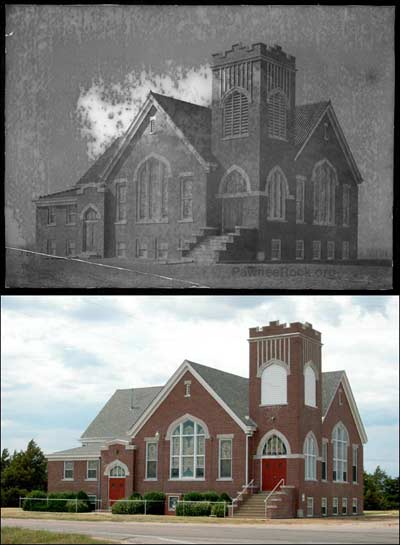
[June 30] It seems that Bergthal Mennonite Church -- the red-brick edifice three miles north of Pawnee Rock -- never changed. At least, it didn't seem to during the 18 years I attended and in the years later when I returned occasionally as a college student. Photography, however, tells a different story. I found the black and white photo in a box of prints I got from my dad. The second photo is one I took four years ago. The top photo shows the church about the time it was built in 1915. There's no landscaping, just flat land at the top of the rise at the crossroads. The roof appears to be composed of tiles. The signboard and silver-painted pipe fence visible in the second photo were added later, along with the shrubs. The shelter belt, no longer a place where vacation Bible school students can picnic among the cedars and elms as they did in the 1960s, has matured. The bell tower, in the 2006 photo, is now boarded up and the big doors are painted red. For many years, they were yellow. A fine old home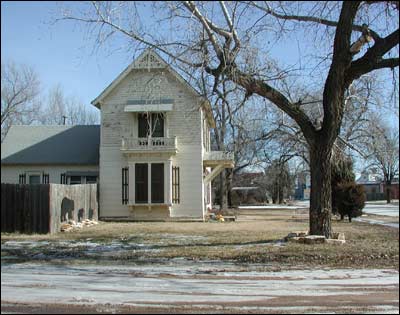
Elegantly structured house at Pawnee Avenue and Rock Street in Pawnee Rock, photographed in 2005. [June 29] One of the joys of returning to Pawnee Rock is renewing my passing acquaintance with the fine old homes lining Pawnee and Cunnife avenues. These frame houses -- their two stories rising high above the bungalows and ranch-style structures making up much of the town -- remind us of the glory days when Pawnee Rock was a thriving town. Prosperous merchants and landowners constructed these houses with fancy trim outside and nice woodwork inside. The houses were built when Pawnee Rock's residents saw a bright future, when Centre Street was lined shoulder-to-shoulder with mercantiles and barbershops and fledgling grain and lumber empires. To be honest, the majority of Pawnee Rockers probably felt some jealousy, because rural areas were poor. I feel jealous sometimes when I walk the streets, wishing in retrospect that our family had held title to one of the fine old homes instead of the fine new home my parents built over a basement home on a double lot along Santa Fe Avenue. I think I imagined back as a kid that boys growing up in the big homes had a different kind of fun, the classic activities we read about in the Cappy Dick books, which were outdated even in the 1960s. I know now that the older places often have insulation that consists of lathe and plaster, that the original pipes are as fragile as old bones, and that the wiring was something to fear. They were coated inside and out with lead paint. The elm saplings planted in their yards a hundred years ago have risen to shade the yard and then expired or saw their crowns butchered. Model T cars and trucks sat in the back yard, then Studebakers and heavy Buicks, and now Fords and Dodges. Families, bursting with children, have come and gone like the seasons as the decades passed. And still the houses are there. They belong to families, and they are also a bit of our hometown's shared heritage. Hello, Mike Dougherty[June 28] Mike Dougherty was three years ahead of me in the Pawnee Rock schools, so I didn't know him well but I did know him well enough to like him. He had the kind of personality that set people at ease -- an easy smile, a polite manner -- and his family lived way over near Great Bend, which made him a bit special because he drove so far every day just to be with us. So it was with pleasure that I opened an e-mail from him Sunday. He brings us up to date with his life and career, and he asked to be listed on the Friends of Pawnee Rock page, where his Pawnee Rock connection and remarks appear. Here's his message:
This summer I've been back to central Kansas for a funeral and a family reunion, but it doesn't look like my schedule will allow a trip back for the PRHS reunion in August. I'd like to stay in touch for future events, though. The August reunion, by the way, is described here. The man who could have been rich[June 25] Barton County had a mechanical genius who did not receive a cent for his invention, which he thought would have transformed rail travel. As it turns out, his idea was eventually adopted by railroads. If Mr. Unruh, of Dundee, had bothered to patent his invention, he might have become rich. As it was, he sat on his idea. This little biography came from "The Biographical History of Barton County, Kansas," published in 1912. Henry Benjamin UnruhThe subject of this sketch, Henry B. Unruh, came to Barton county in 1876 from Pennsylvania where he first located after leaving the old country where he was born in Russia-Poland, in 1852. By trade he is a weaver and sawyer but upon his arrival in this county he immediately took up the business of farming and located in the Mennonite Colony near Dundee. His home place consists of about 220 acres of land all of which is in a high state of cultivation. Mr. Unruh was married in 1873 to Miss Susan Dirks. Mr. Unruh survived his first wife who died in 1901. They were the parents of ten children. Mr. Unruh married Miss Kate Johnson of South Dakota, in 1902, and they have been blessed with four children. Mr. Unruh's mother died in the Old Country and his father passed away in this country in 1910. Mr. Unruh's farm is one of the best developed in that part of the county and he has always had it well stocked with the best of horses and cattle and all the necessary machinery for successful farming. With all Mr. Uuruh's work he has found time to work out and perfect an invention on which he has the patent that is some day destined to revolutionize the science of railroad building. The invention consists of an endless or continuous rail. It has received the endorsement of some of the leading railroad men of the country and had Mr. Unruh been so inclined he could have sold the rights to manufacture the rail to an eastern outfit but as they wanted it all without giving anything in return their offer was not accepted by Mr. Unruh. The invention is one of the most perfect of contrivances and it will do away with the jar and noise caused when a train goes from one rail to the next on the ordinary railroad. Mr. Unruh is in no hurry to dispose of his patent but is now contemplating the organization of a stock company to manufacture and sell the rails of his construction. Mr. Unruh is one of the best known men in the county and his invention has brought him no little fame and will in time reward him in a more substantial way. The farmer and his combine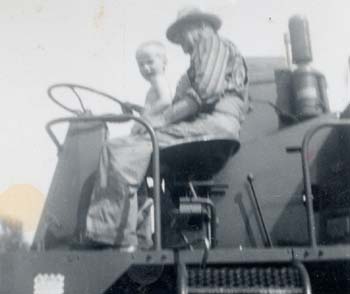
[June 24] At the top of this post is a photo of a very young me on my grandpa's combine. It must have been taken on his farm around 1960, and you can tell that I'm having a good time. I think it's the only photo I have of me with Grandpa. Aside from we two Unruhs, there's not a lot in that open-air cab. A steering wheel with a suicide knob, pedals, and various levers to operate the reel and augur. There was nothing there that couldn't stand to be rained on, and all the moving parts were well greased with a steel gun packed with lovely translucent lubricant loaded from a large bucket. Even the seat cushion withstood the elements, and it barely made the steel seat more comfortable. Grandpa -- Otis Unruh -- ran the combine over about 120 acres of wheat and milo; the rest of the farm was pasture and homestead. He also rented some land a mile or two west. Harvest was a big deal; he was on the combine as soon as the grain dried out in the morning and worked until the stars were out. We kids provided moral support -- we clamored to play in the back of the truck after it was filled with wheat. Grandma provided material support -- she brought the fried chicken and steel Coleman jug filled with water and chunks of ice. After lunch, Grandpa kept the Coleman, and when he emptied the bin into the truck we'd see him lift the jug and pour the water right into his gullet. You might remember the sound of Allis Chalmerses and International Harvesters clattering around as you stood outside in the dusk. Maybe you saw their headlights in the distance as you drove up U.S. 56. These farmers knew their land intimately -- the terraces, the gullies, the soft spots that dried out last. Sitting in the outdoors, wearing a straw hat or -- for the smart ones -- luxuriating under a faded cloth umbrella, they knew the weather: the aridity, the dust, the convection heat, the freshets that came on the toes of a thunderstorm.
Back in 2000, I drove my sons, then ages 4 and 2, across Kansas as my wife pedaled in Biking Across Kansas. We tagged along her route for a while, then dropped down to Pawnee Rock and eventually headed north and east across the shimmering cropland. On a whim, I stopped by a giant John Deere 9750 STS combine sitting alone in a field near Frederick. Minutes later, its driver and another man drove up in an eighteen-wheel wheat truck. I played the Alaska card -- "Hi. I grew up in Pawnee Rock, but my sons are from Alaska and have never seen a combine up close." Not only did the farmer invite us onto his combine, which was a top-of-the-line model lent by John Deere, but he also drove us around the field while he cut his crop of 40 to 50 bushels an acre. He showed us his GPS recorder, which noted on a digital map where the combine found the crop to be bountiful and where it was (relatively) meager. Later, when he planted and fertilized, he would feed the data into a GPS unit on his tractor, and the proper amount of seed and nutrients would be delivered precisely and efficiently to boost the next yield to a uniform bumper crop.
His cab boasted air conditioning, of course, and the farmer pointed out the radio (AM, FM, weather) and a CD player. His chair was very comfortable (there were two comfy upholstered seats), and the cabin had room for two adults and two children. Our fortunate farmer might have had a jug of ice water, but he wouldn't have needed it. Did he know his land like Grandpa did? Maybe. Odds are, though, that if he was successful enough to come to John Deere's attention, he must have had thousands of acres that blended together into a sea of amber waves. I would bet that the computer knew his land better than he did. The most important thing, however, was that he, like Otis Unruh, was proud of his combine and he loved to show it off to wide-eyed little boys.
HorseThief Reservoir's grand opening[June 24] If you've been waiting for the new HorseThief Reservoir to open officially, head to Jetmore this weekend for the celebration. The lake is eight miles west of town, about 60 miles west of Pawnee Rock. The campgrounds aren't ready, but the boat ramps and picnic areas will be, according to a story in the Dodge City Globe. There won't be any charge this weekend for parking. Shade is scarce, the park manager said. When the deputies fired Pawnee Rock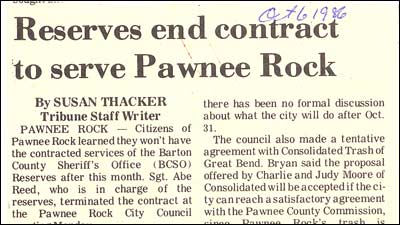
[June 23] It's not often that a town's security service fires the town, but that's what happened in October 1986 when the Barton County Sheriff's Office reserve announced it was ending its contract with Pawnee Rock. The city had contracted with the reserves for three years. The contract was to end on that most feared day, Halloween, the night when goblins historically and notoriously littered the streets with combine tires, jungle gyms, and branches. And threw rocks at the city's old fire bell. Sixteen citizens were in attendance at the city council meeting when this was announced by the sergeant in charge of the reserves, Abe Reed. "A lot of it was due to lack of manpower on our part, and my people were losing interest in it," Reed told Susan Thacker of the Tribune the next day. He added that the reserves were getting complaints from Pawnee Rock's residents. "There's no kind of hard feelings at all," Reed said. Still, the reserves were taking their sirens and going back to Great Bend. One might assume that the reserves were being paid a fair amount, since that issue wasn't raised. The city clerk, Doris Bryan, told the Tribune that there hadn't been any serious discussion about who would patrol the city starting the day after Halloween. The sheriff's office would continue to patrol the city as part of its regular rounds. That wasn't the only news to come from the city council meeting. The town's elders also voted to: • Hire Consolidated Trash of Great Bend to handle the city's refuse. Major Astro, our man in space[June 22] As all the world knows, Major Astro has died. His other name was Tom Leahy, and he was 87 years old when he became one with the universe last Friday in Wichita. Like many kids my age in the 1960s, I was a close follower. I too hurried home from school so I could warm up the Zenith and watch him on his inexpensive set at the Wichita TV station -- but weren't all of us kids during the Space Race years so willing to suspend our disbelief that we didn't pay attention to the furniture? (See the examples in the slide show that accompanies Becky Tanner's story in the Eagle.) He had contests intended to draw us kids in. For example, over the course of the show he would mention three space-related words, and we were to write those words on a postcard (he showed us a demonstration card with a list composed of three "space word" items) and mail it to him in the hope that it would be drawn from his big squirrel cage. I attended to his instructions so fervently that my first postcard listed "space word" three times. Eventually I got it right, and he rewarded me with a packet of 10 state fair ride tickets. (In case I had missed the show and wasn't shouting wildly in front of the TV, a schoolmate's mother called to make sure my mom knew.) On a different occasion, Major Astro sent me a plastic moon globe -- with craters in relief -- that doubled as a bank, and half the moon glowed in the dark. Another time, we drove to Hutch to watch him land in a helicopter at a new store, perhaps a Gibson's. It was a crowd as big as all of Pawnee Rock's population, and it was the first helicopter I ever saw. My debt to Major Astro is immense. He was a cheerful advocate of astronomy and rocket science, and he encouraged each of his young believers to look into the sky and to imagine. To imagine. One fire photo
[June 21] While prowling through my negatives from the 1970s, I came across a couple of rolls that documented my first expedition as a cub photojournalist. The occasion was a fire in a barn/garage at a home near the river east or southeast of town, and I think it happened on a Saturday. Because I lived next to the fire station and had a brand-new driver's license, I chased the truck and, once I got there, pretended to know what I was doing as I stood at the fringe and framed the scenes. It helped that almost everyone at the fire knew me, although I don't think the gray-haired woman whose property was burning did. As she stood behind her yard's wire fence, there must have been 20 guys from Pawnee Rock milling around her building, spraying into with a pumper's two-inch hose and putting on yellow coats and the city's new scuba-like breathing gear so they could enter the building and pull out smoldering hay bales. Although there was real property at stake, it would be naive to think that the fire crew wasn't also thrilled to have a good reason to test the gear. I sold a photo from the fire to the Great Bend Tribune for a piddly amount, maybe $3 or $5, but it was the most important photo I ever sold because it got me started. It wasn't the shot shown here. This photo shows two of my neighbors, Tom Flick and his son Doug, as Tom prepares to wade into the smoke. I remember Doug being fairly excited about getting his dad ready. I also like the shot because it brings to mind a couple of guys I remember not nearly as well as I would like to. Doug was in the class ahead of mine and something of a wild guy, at least by Pawnee Rock school standards. From the perspective of three decades hence, I think he must have been a fun guy. He once helped me through a bad spot at Scout camp in the summer after my sixth grade, and he told funny jokes when the troop camped at the river. All in all, the photo was worth keeping. Company C, 23d Battalion
Pawnee Rock members of the Kansas State Guard. Elgie Unruh provided this photo. [June 18] Were it not for a $1,000 appropriation from the Kansas legislature for someone to write the history of the Kansas State Guard, we would likely know nothing of the men who protected the homeland, provided honor guards at "entrainments" of recruits and at funerals of soldiers who had died (by battle or by influenza), and acted out sham battles for the pleasure of picnic-goers across Kansas during the First World War. The "History and Roster of the Kansas State Guard, August 6, 1917, to November 11, 1919" was published in 1925. Here's what M.R. McLean, the state's adjutant general wrote: "The Kansas State Guard took a very important part in the world's greatest conflict. In addition to training the youth to enter the federal service, performing guard duty, and assisting the various drives to finance our combat troops, they maintained the patriotism of the communities at, high ebb and inspired all civilians to revere the name of America, which was an invaluable aid to the state." Following are a roster and some of the activities the guardsmen participated in. "Company C performed police duty for the city for a period of six months; officer of the day at county fairs of Pawnee and Barton counties, and furnished military escorts at funerals of deceased soldiers returned from camps for burial." COMPANY C, 23D BATTALION, Pawnee Rock.ACTIVITIES. "Company C performed police duty for the city for a period of six months; officer of the day at county fairs of Pawnee and Barton counties, and furnished military escorts at funerals of deceased soldiers returned from camps for burial." Captain: LOSSES. First Lieutenant:
Source: Blue Skyways. Watching the river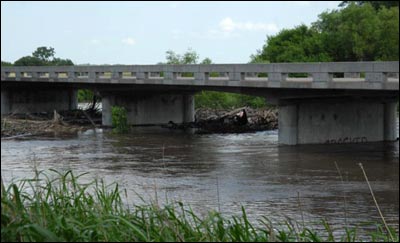
The Arkansas River at the Pawnee Rock Bridge on June 16. Jim Dye made this photo. [June 17] The Hutch News has had several stories about the damage that last weekend's rain has done to the wheat crop and about how the cops are pleading with adventurers to not go tubing on Cow Creek or the Arkansas River during the flood. I can tell you that kids who grew up along the river and actually played in it are too smart for such craziness. We know that there are nasty logs and snakes riding the waves and that the high water carries a lovely assortment of farm chemicals. Besides, a river near flood stage will do what it wants with anyone who loses his balance. This is a good time to watch the water go by. In fact, yesterday Doyle Mayse of the Pawnee County Sheriff's Office did just that. Here's his note: "Has anyone sent you pictures of all the water south of Pawnee Rock? We were out there the other day but I didn't think to take a camera with me. A lot of side roads were under water because of that little creek, the Arkansas River is really up and going it was almost up to the bottom of the bridge, the ditches were flowing into the river too. We ran into a water logged muskrat who didn't know where to go, he was on the road and didn't act right, he would get in and swim around a little while and then get out and just stand on the road. It's nice to see that much water in the river. Been a long time since the river has been cleaned out." A few hours later, Jim Dye sent photos from the river. A couple are on the home page today, and here's another one showing the condition of the water. (Remember the golden days when we'd all wonder whether the pre-2000 wooden bridge could stand the strain?) Upstream, a few miles south, the U.S. Geological Survey maintains a gage at the O'Rourke Bridge. On Wednesday, it showed the river cresting over 11 feet after rising about 7 feet since the rain. (See the frequently updated charts for river height, water volume, and rainfall.)
The Arkansas River rose past 11 feet Wednesday at the O'Rourke Bridge. How old are those trucks?[June 17] Leon Miller, Pawnee Rock High Class of 1951 and now of Dallas, recalls the wheat trucks photographed by Paul Schmidt and posted on the site yesterday with an uncertain date. "My guess is the picture taken of the grain trucks was actually in the late 1940s. I recall my dad having a Chevrolet truck similar to the one in the first photograph and he bought it in the early '40s, maybe a 1942 model. There are other trucks in the second photo that date to the 1930s; note a couple of pick-ups in line to unload their wheat. I remember a fellow named DeLos Carr who farmed south of town near the river and had a Dodge pickup to haul his wheat." What if BP were your neighbor?[June 16] Kansas has had its share of disasters: tornadoes, floods, droughts, grasshoppers, that church in Topeka. But imagine the British Petroleum oil spill if it were on -- and in -- the farmland, streets, playgrounds, aquifers, and streams of the Sunflower State. It's one thing to think of the abstract, faraway Gulf of Mexico, which is so big that I can't comprehend its size easily. It's another thing when you can take the surface area of the spill and plop it down on Pawnee Rock. And remember -- the BP spill isn't just on the surface. It has spread throughout the water, big plumes of it. . . . I don't know why I'm telling you this. You live closer to it than I do and you probably can recite the stats forward and backward. Go to If It Was My Home and type in "Pawnee Rock, KS" or wherever you live now. Then see how far you'd have to drive to get out of the oil. Harvesting history through photos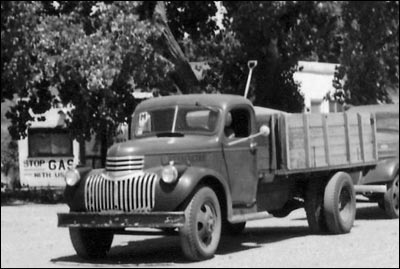
A detail from one of Paul Schmidt's photos of wheat trucks lined up on Central Street in the early 1950s.
The construction of the steel bins making up the highway-side elevator in 1951. Paul Schmidt took these photos, and Barb Schmidt sent them to us. [June 16] Barb Schmidt of Seattle has sent more wonderful photos taken by her dad, Paul. These include early 1950s scenes that are new to me -- yesterday's shot of the steel-bin elevator under construction and today's photos of the trucks lined up on Centre Street. The truck photos show Pawnee Rock not long before much of the city's individuality was stripped away. The ten light poles in the middle of Centre survived for a few more years (they are a hazy image at the edge of my own memories of downtown), and the sidewalks are shaded with elms. Along Centre are stores and shops in brick buildings that disappeared in the ensuing decade and a half. I don't know what Paul Schmidt's motivation was in making these photos, but I am grateful that he hopped out of his truck and shot the long line. They're common scenes, but rare photographs. They help me understand the curve of our hometown's history. Did Paul plan for us to look at these images 60 years into the future? Probably not, but he had the foresight to save them, and Barb -- who was born about the time Paul took the photos -- has been a worthy curator. Here is the note Barb sent with the photos: Attached are photos my dad took in PR during wheat harvest in the early 1950s. My guess is 1951, but maybe someone who can identify model years of the trucks can better peg the exact year. The trucks lined up on Centre Street were probably heading for the Gano Grain elevator along the highway, which is where Dad sold all his wheat in 1951, except for one load sold to Farmer's Grain elevator on July 10. In his farm journals for 1951, Dad recorded cash wheat sales starting on July 2 and continuing through July 20, with the price per bushel in the $2.05 to $2.10 range. I don't remember all the reasons why dad chose one elevator over another. Sometimes one offered a better price. Once in a while an elevator would be "full" and waiting for a train to come and haul away as much grain as possible before it could accept any more wheat. But then "waiting" occupies much of the lives of all farmers, who must constantly wait and choose the right time to do so much of what they do and then wait some more for the weather to let them do it. Can one of your readers tell us the price of wheat at harvest time in PR this year? Hunt for Chapman continues[June 15] The Barton County Sheriff's Office said Monday that the manhunt continues for Jeffery Wade Chapman, who is accused of stabbing his brother, Raymond, on Saturday in Pawnee Rock. (Full story) Warren Peterson dies[June 15] Warren Peterson, who was born in 1918 on the family farm near Pawnee Rock, died last week at the Kansas Soldiers Home at Fort Dodge. Mr. Peterson, was a custom cutter and was 91 years old. He is survived by nephews Donald Peterson of Larned and Darryl Peterson of Hutchinson and by nieces Yvonne Wittig of Larned and Lark Peterson of Pawnee Rock. Mr. Peterson will be buried this morning in the Larned Cemetery with military honors. (Full obituary) Purple signs and hunters
Gary Eitel wrote: Down in our corner of the state the purple signs or purple painted on a fence post means "no hunting allowed" or even possibly that the land is leased already to some hunters but think the first explanation is the right one. It is getting increasingly hard for hunters to get permissions to go hunting on farmers land anymore because of the abuse that can happen and the liability problem if anything drastic happens while they are there. In my case -- they sometimes stray from where they are given permission and most times just plain don't ask and help themselves. Too many times some of them are scouting for tractors etc that are left in fields and pull a ripoff of tools etc. that may have been left in them. Hydraulic cylinders have been found missing also -- much of this happens during the fall hunting season when deer/turkey season is on. One finds holes shot in combines and tractor windows or radiators -- just a plain lack of respect and they leave all their beer cans behind also -- have had some out there at 9 PM in the pitch darkness hollering and shooting their guns when there is no good reason to do so -- hunting is for daylight hrs only -- enough said. The state of KS has a program available that farmers can sign up for that if he has hunting property available, he gets like $2/acre with a minimum of 80 acres involved and the state keeps up with who gets to hunt there then. This is how it is happening in our part of the state and has just been taken place in the last several years now. Larry Mix sent this: You asked about the purple signs you seen near Pawnee Rock, this might be the explanation of what is happening. Man stabbed in Pawnee Rock
Medical personnel move the stabbing victim to the EagleMed helicopter parked on U.S. Highway 56. Jim Dye made these photos. [June 14] Photographer Jim Dye was on the spot when a medical helicopter and the sheriff's department responded to a stabbing Saturday morning at Flora Avenue and Rock Street. For former Pawnee Rock residents, it was in the old Ingram house. The Barton County sheriff's office said Raymond Chapman was stabbed, and they were searching for his younger brother Jeffrey. The story made the Great Bend and Hutch newspapers as well as at least one TV station in Wichita. If the "Chapman" name seems familiar in a crime context, maybe it's because of this: Duffie Roland Chapman was convicted in 2007 of stabbing his wife, Treasa Lynn Carter, to death at 515 Rock Street. Jim said the deputies told him they were seeking a black Suburban, and they stopped a large SUV nearby at gunpoint. It turned out not to be the suspect's. Jim sent me the photos Saturday afternoon, and I wish I could have posted them then. Unfortunately, I was out of town and did not see them until Sunday night. This was big news, and I'm glad Jim was there.
A Barton County sheriff's deputy aims his pistol at a man driving an SUV in Pawnee Rock as the search began Saturday for Jeffrey Chapman. The driver was not Chapman. Jim Dye made this photo. Heavy rains[June 14] It was a wet weekend in Pawnee Rock. The National Weather Service says 1.78 inches of rain fell at the Great Bend airport, so Pawnee Rock probably got that, more or less. Larry Mix of St. John wrote that he got two and a half inches. More than six inches was reported closer to Hutchinson. This can't be good for the wheat. Purple signs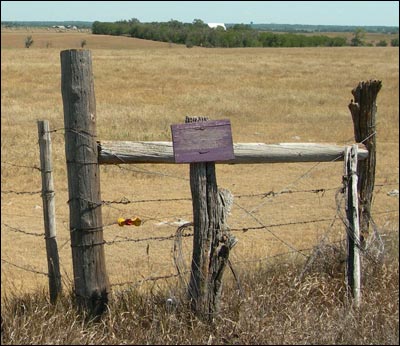
Purple sign northwest of Pawnee Rock, 2006. [June 10] I knew I had been out of state too long when I saw purple-painted boards on a dozen rural corners. Not one of the boards had lettering, and they were all about the same size. They were all on posts, nothing fancy. There was even one on the former farm of my grandparents, the corner up by Elrick/Mark Smith's farm. The obvious guess is that the boards were related to the state's agricultural college -- a simple and subtle marking of territory. It made me think of the Bill Snyder football years, when all of a sudden that stylized Wildcat was everywhere. Can someone please supply the details about these boards? Was there a publicity push by Silo Tech to have the boards erected? Did they used to have words? Was it a grassroots movement, or were they set out by the county extension agents? Was there any backlash by the folks from Harvard on the Kaw? Fading out of focus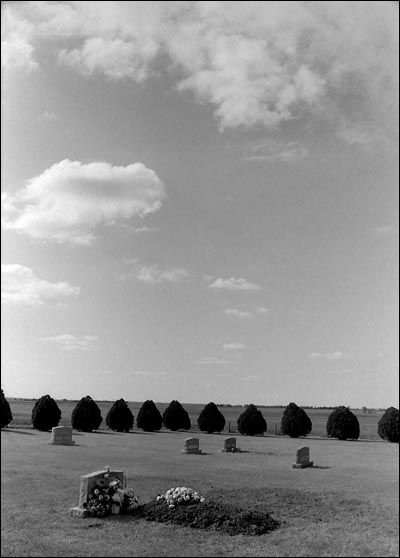
Lena Unruh's fresh grave, Mennonite Cemetery, Pawnee Rock. [June 10] I wish I remembered my Grandma Unruh better. Aside from a few vivid memories, most of what comes to mind is a sense of Grandma instead of details. They're like this photo, which my dad took.
That's Grandma -- Lena O. (there was another Lena Unruh, so ours was given "O" for a middle initial because it identified her as Otis' wife) -- about 1979, with the last of the dogs named Shep, on her porch swing on the south side of her farmhouse northwest of town. The swing is tied with twine to a post so it won't swing too hard in the south wind and bang on the air conditioner. Grandma used twine the way I use duct tape. It was a different time. In the photo, Grandma is out of focus, and her descending years were much that way; the loss of her faculties led to long days tied with a sheet into a wheelchair at the nursing home in Great Bend. On my last visit, with Dad, she didn't know me. She died one evening when I was working at the newspaper in Dallas. Dad called and gently but directly gave me the details of her departure and of the coming funeral. After I hung up, I wasn't quite sure what to make of the news; after Grandpa died early on a Saturday in 1965, Dad paced our living-room floor and Mom told nine-year-old me in a hushed tone that Grandpa had had a heart attack in bed and that Grandma had called for an ambulance but it arrived too late. For the rest of her life on the farm, Grandma slept in that bed. Except, that is, for winter weeks when she closed off the parlor and the upstairs and her bedroom downstairs so she wouldn't have to burn propane heating those rooms. Then she slept on a cot next to the furnace in the dining room and you still could have stored meat there. She washed dishes in Tide and broke her tray ice apart with a pick. She wore black rubber galoshes, and old-woman dresses in the 1950s styles, and a jacket constructed out of denim. Outdoors, she wore a scarf over her hair. She told about how in the Thirties she had hung wet sheets over the doors and windows to keep the dust from pushing into the house. She baked bread for each of the successive Sheps. She kept hens in the chicken house and, for a while, geese in the yard and a parakeet in the dining room. Grandma kept to her friends, speaking Low German on the party line and going to Boogart's in Great Bend to buy her groceries. She didn't go to basketball games or to see Santa downtown. She went to church and made quilts and oversaw the farmstead and big family dinners; she had her place in life. She was Grandpa's second wife; his first had died in childbirth shortly after World War I. Grandma's departure wasn't like Otis'. This time, almost 25 years after Grandpa died, her death was not a surprise. At her funeral, we cousins gathered with her children and posed for photos on the church stage; even her feuding sons stood together on this day only. The combine sweeps through the field and we all will go, one row after another. We learn later how valuable the earlier generations were, and we become deeply curious about the Christians and Lizzys and Antons and Orels and all the other folks closer to the trunk of the family tree. We clutch at the familiar tales and dig for new details, because we know their stories won't be told anymore unless we learn them, and their stories are our stories. Grandma's farmhouse was torn down and pushed into a trench. There's nothing left of her generation but heirlooms distributed among the cousins, photographs of varying quality, and the tidbits we carry in our hearts, minds, and genes. Grandma Unruh is of the past. She died 20 years and one month ago today, and she was buried next to Otis in the Mennonite Cemetery on a bright, windy morning, and lunch was served later at the church. Dust to dust: there's nothing left of my Lena Unruh but the perspective I gain from examining her life. In that regard, Grandma Unruh is part of me, and part of us all. What it's like when it rains
[June 8] One of my favorite poems came from Boys Life magazine. The thunder roared. After a lot of years, I'm back in the land of thunderboomers and jagged lightning. Not the Kansas or Texas kind, but still the product of hot summer days. The difference is that the storms never arrive at night, because it never becomes night this time of year, so the fright factor goes way down. In Pawnee Rock, however, the storms still slip across the plains when decent people are trying to sleep. A couple of days ago, one pack of storms came at 3:30 a.m., and another set came through before noon. It's not good for the wheat or swimming pool attendance, but it's helpful for a lot of other things. Probably. The "sense" of heavy rain is a good one, as long as you're snug at home or at work. Knowing that the gullywasher is pooling in the bermuda grass or making the dirt roads impassable is part of life in our hometown. It still strikes me as something of a miracle that so much water can find its way downhill off such flat land. Here are a couple of photos that say "rain" to me. The first was taken off our front porch back in the 1970s, looking across Santa Fe Avenue during a soaker. The second photo is of a vacant lot east of the Days Inn in Great Bend during a wet August night. 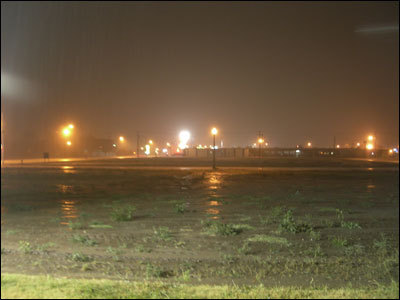
Swinging by Hutch[June 8] Those of us who drive (or drove) frequently to Hutchinson are familiar with the gaunt concrete elevator standing on the Rayl Hill on Fourth Street west of Hutch. There's also a state historical marker nearby commemorating a presidential visit. Hidden behind the trees and years of disuse is another treasure -- the site of an old dance club. I bet that some Pawnee Rockers hotfooted it around the floor way back when. Check out Kathy Hanks' story in the Hutch News. A side note: Look closely at the photo with the story. See how many small memories come back -- the "lost" concrete floor, the grass and wildflowers pushing their way up through the cracks, the carpet of twigs beneath the branches. Remembering Jim Clawson[June 8] Yesterday this page carried a request from Ronnie Webb, who was looking for Jim Clawson. Roger Hanhardt followed up: "Jim was the son of A.B, aka. Pawnee Garage. He was my classmate, and is the only one of our 1964 class that is deceased. He died at age 42." Also: Another friend of the family who used to babysit (but prefers not to have her name posted) pointed that Jim has died. She directs us to earlier notes from Jim's son Corey and daughter Jamie. Furthermore: Chagrined that I had not searched PawneeRock.org for tidbits about Jim before posting Mr. Webb's query, I searched the web for "jim clawson" and came up with a couple of mentions. Now, I know you can't tell a man's story with one photo, but it's likely that Jim was proud of his race car, "the Happy Hooker," and that the photo of it carries a bit of his spirit. (See photo, scroll to the bottom). Also visit this page (again, scroll down). Nicolette Unruh, a grad with honors[June 7] Nicolette Unruh of Pawnee Rock graduated from Bethany College late last month with honors in theatre and communication arts. She was last fall's football homecoming queen. Nicolette is the daughter of Dale and Berny Unruh. She graduated four years ago from Larned High School. Seeking Jim Clawson[June 7] A man named Ronnie Webb is looking for Jim Clawson, with whom he served in Vietnam. If you can help, send an e-mail to Ronnie at PR-webbauto@comcast.net. Delete the "PR-" from the address before sending the e-mail. Here is what Ronnie wrote: I am trying to find an old army buddy by the name of Jim Clawson. He would be 62-63. We were in AIT together and left for Viet Nam at the same time but he was sent to the Delta and me to the Central Highlands. My name is Ronnie Webb from Athens, Tennessee, if you can find him for me. Thank you so much for any information you can find. Ronnie Bustling towns of the past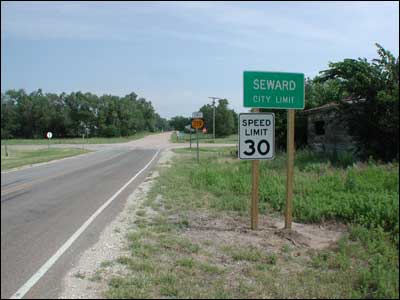
Seward in 2005. [June 4] We're used to thinking of Pawnee Rock as a nice place to live but not exactly a shopping destination. A hundred years ago, however, our hometown was a bustling place -- and so were some of its neighbors. These descriptions are excerpts from "Kansas: A Cyclopedia of State History," which was published in 1912 in Chicago and (now in the public domain) republished on Blue Skyways, a state-operated website. All of these towns are still here -- to some degree -- except for Ray, which was a mile north of K-19 and three miles west of Radium. Radium, by the way, wasn't described in the history book. Pawnee Rock, one of the incorporated towns of Barton county, is located near the historic Pawnee Rock, on the Santa Fe trail. It is a station on the Atchison, Topeka & Santa Fe R. R. 14 miles southwest of Great Bend, the county seat. It has a bank, a weekly newspaper (the Herald), about two dozen retail stores, telegraph and express offices, and a money order postoffice with two rural routes. The population according to the census of 1910 was 458. Dundee, a village of Barton county, is a station on the Atchison, Topeka & Santa Fe R. R. 8 miles southwest of Great Bend, the county seat, from which place mail is received by rural delivery. It has a local trade, does some shipping, and in 1910 reported a population of 68. Albert, a prosperous little town of Barton county, is near the western boundary, and is a station on the Great Bend and Scott division of the Atchison, Topeka & Santa Fe R. R., 15 miles from Great Bend. Albert has a bank, a money order postoffice with one rural delivery' route, large grain elevators, several good mercantile houses, and in 1910 reported a population of 250. Heizer, one of the villages of Barton county, is located in Buffalo township on the Atchison Topeka & Santa Fe R. R., 8 miles northwest of Great Bend, the county seat. It has a mill, an elevator, several retail stores, telegraph and express offices, and a money order postoffice. The population according to the census of 1910 was 75. Macksville, an incorporated city of the third class in Stafford county, is located in Farmington township on the Atchison, Topeka & Santa Fe R. R., 12 miles west of St. John, the county seat. It has 2 banks, a weekly newspaper (the Enterprise), all the leading lines of merchandising, telegraph and express offices, and an international money order postoffice with two rural routes. The population according to the census of 1910 was 626. It was settled in 1878. Ray, a post-village in Pawnee county, is located in River township on the Missouri Pacific R. R., 8 miles east of Larned, the county seat. It has general stores, 2 grain elevators, telegraph and express offices. The population in 1910 was 60. Seward, a little town in Stafford county, is located in the township of the same name, on the Missouri Pacific R. R. 13 miles north of Stafford, the county seat. It has a hotel, a creamery, a bank, retail stores, telegraph and express offices and a money order postoffice with one rural route. The population in 1910 was 300. Hoisington, the second largest town of Barton county, is located on the Missouri Pacific R. R. 11 miles north of Great Bend, the county seat, with which it is connected by a branch of the Missouri Pacific. There are 2 banks, a weekly newspaper (the Dispatch), mills and elevators, electric lights, good hotels, well stocked mercantile establishments, an automobile livery, which makes daily trips to Great Bend and other towns, 4 churches, a public library and good schools. The town is supplied with telegraph and express offices and has an international money order postoffice with two rural routes. Hoisington is a growing town, the population in 1910 being 1,975, as against 789 ten years before. Great Bend, the county seat of Barton county, is one of the thriving little cities of central Kansas. It is located at the historic big bend of the Arkansas river, and is on the main line of the Atchison, Topeka & Santa Fe R. R., a branch of which diverges at this point and runs northwest into Rush county. A branch of the Missouri Pacific extends from Hoisington to Great Bend. The town has electricity for light and power, waterworks, fire department, sewer system, a college, public library, 8 churches, an opera house, 3 banks, grain elevators, flour mills, a creamery, an ice plant, a mattress factory, a broom factory, 3 newspapers (the Tribune and Democrat, both daily, and weekly, and the Press, a weekly). A religious monthly is also published. There is a daily stage to Hoisington. There are a number of stores well stocked with merchandise, a good court-house and school house. The town is supplied with express and telegraph offices and has an international money order postoffice with six rural routes. The population according to the census of 1910 was 4,622. Larned, the county seat of Pawnee county, is located northeast of the center of the county on the Atchison, Topeka & Santa Fe and the Missouri Pacific railroads, and at the confluence of the Pawnee and the Arkansas rivers. Its altitude is 2,002 feet. It is in the wheat belt of the state and is the trading and shipping point for a large agricultural and stock raising section. There are several blocks of substantial business houses, 2 newspapers (the Tiller and Toiler and the Chronoscope), 3 banks with a combined capital of $125,000 and deposits amounting to over $850,000, a fine city hall, an opera house, a hospital, a city park, waterworks, electricity for lighting and power, a fire department, a sewer system, all the leading church denominations, a creamery, 2 flour mills, a foundry, several grain elevators, etc. The city is supplied with telegraph and express offices and has an international money order postoffice with four rural routes. The population, according to the census of 1910, was 2,911, a gain of 1,328 since 1900. The flowers of summer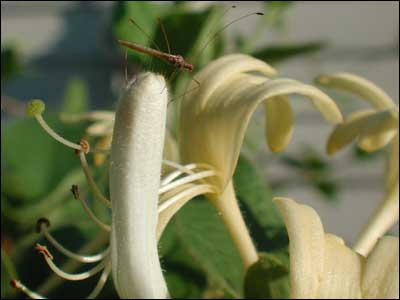
Honeysuckle. 
Hollyhock. [June 3] We had a honeysuckle vine just behind our house on Santa Fe Avenue, and it was the sweetest-smelling plant I've ever known. As you know, honeysuckle blossoms are kind of odd looking, and for certain kids that is an invitation to strip them down to the nubbins to see what's inside. And then there were the hollyhocks, the rough-legged tall plants that grew near near the honeysuckle's trellis. Hollyhocks are straightforward: no curlicues, no arabesques, no entrancing scent, but lots of color. They're as earnest as a pinkish-red flower can be. Ever since my dad moved out of Pawnee Rock a few years ago, I haven't had a place where I know I could go to see hollyhocks. I miss that. But during our recent move from the chilly, mountainous coast of Alaska to the sunny and warm interior, I came across a packet of hollyhock buttons that I had pulled off a plant back in 2006. It may be too late to plant them this summer, but I'm going to give it a try next year and see how they thrive in 24-hour sunlight. Even if the seems come through, it won't be the same as it was when I was a youngster. Sometimes, however, you take what you can get.
Highway dreams[June 2] Many's the time I dreamed of putting on sturdy shoes and heading on down the highway, bound for Santa Fe or Florida or Minnesota. As we lived in in the middle of the state that's in the middle of the Lower 48, it wouldn't have been a very long walk to anywhere. I had my one-quart canteen and my heavy pack, plus my Boy Scout knife. I was ready to go. But then, as life goes, I went on to something else. Yesterday, I read about a fellow who is living out my dream. He started on the east coast and is planning to walk for nine months just to see where it takes him. After two months, he's in Minnesota. I like this guy. I wish I were in his shoes. Photos from the Memorial Day service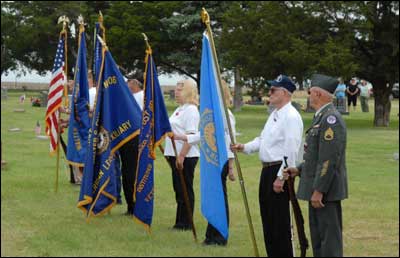
[June 1] Yesterday's Memorial Day service drew a few dozen folks to the Pawnee Rock Cemetery. Helping with the ceremony were an honor guard, a rifle squad, and a bugler, as well as a minister who led the attendees in prayer and a keynote speaker, Pawnee Rock native and retired Army Lt. Col. Bob Dunavan. Thanks to Jim Dye for sending these photos of the service. (If anyone has photos from the reunion at the depot, please send them.)
|
Sell itAdvertise here to an audience that's already interested in Pawnee Rock: Or tell someone happy birthday. Advertise on PawneeRock.org. |
|
|
 Thanks so much for creating and maintaining this remarkable site. I heard
about last year's PRHS reunion after the fact and may not be able to make it
back this year, but would like to stay in contact with PR, PRHS alumni, and
those who have fond memories tied back to our little Mayberry and the SW
corner of Barton County.
Thanks so much for creating and maintaining this remarkable site. I heard
about last year's PRHS reunion after the fact and may not be able to make it
back this year, but would like to stay in contact with PR, PRHS alumni, and
those who have fond memories tied back to our little Mayberry and the SW
corner of Barton County.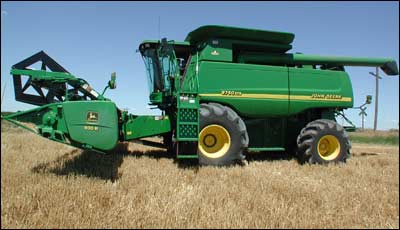
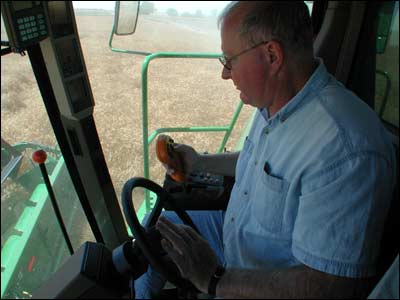
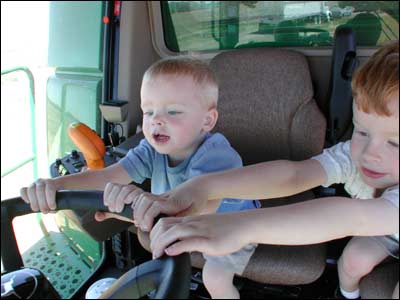
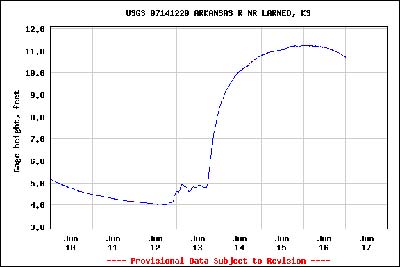
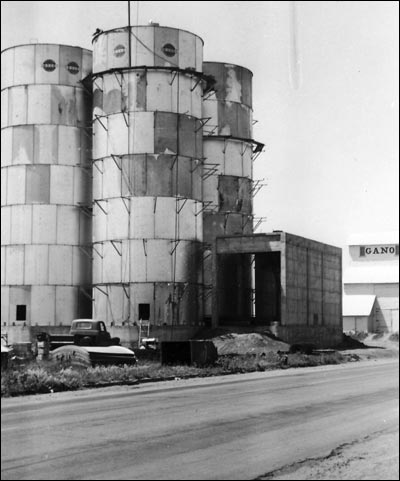
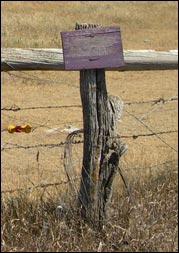 [June 15] My puzzlement over the
[June 15] My puzzlement over the 